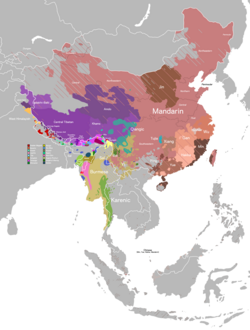Teoyeo dialect
Teoyeo dialect[1] (simplified Chinese: 潮阳话; traditional Chinese: 潮陽話; Pe̍h-ōe-jī: Tiô-iôⁿ-uē) is a dialect of Teochew Min spoken in the historical Teoyeo county, which includes modern Chaoyang, Chaonan, and Haojiang in Shantou, Guangdong, China. Similar dialects are spoken in Huilai county and parts of Puning city. Distribution Teoyeo and related Southern Teochew dialects Teoyeo (潮阳县 / 潮陽縣, Mandarin Cháoyáng) was a historical county of the Teochew prefecture. The current administrative division introduced in 2003 has three units in place of this historical prefecture: Chaoyang (Teoyeo) District, Chaonan (Teonam) District, and Haojiang (Haukang) District. All of these divisions are now subordinate to the Shantou prefecture-level city. The dialect spoken in the former Teoyeo county is very distinct from the urban Swatow and other Northern Teochew dialects, although they are still mutually intelligible to a large degree. Among the Northern Teochew dialects, Kekyeo dialect is relatively closer to Teoyeo. Teoyeo dialect is very similar to the dialects of Huilai and Puning, together classified as "Chaoyang-Puning branch" (潮普片) of the Teochew language.[2][3] In the northernmost areas of Chaoyang District (the Guanbu 關埠 and Jinzao 金灶 towns), a dialect similar to Northern Teochew is spoken. In the south of Chaonan District (the Leiling 雷岭 town) there is an isolated island of Hakka language.[3] PhonologyInitials
The initial /dz/ may be realized as [z], especially when labialized.[4] In Teoyeo, labial initials (/p/, /pʰ/, /b/, /m/) have labiodental allophones ([pf], [pfʰ], [bv], [mv~ɱ]) before /-u-/.[5][6]
Rimes
Unlike northern dialects of Teochew, Teoyeo lacks the vowel /ɯ/ — it regularly merges with /u/ (e.g. Teoyeo 汝 lú and 豬 tu correspond to Northern Teochew 汝 lṳ́ and 豬 tṳ). The general Teochew rime /ɯŋ/ corresponds to Teoyeo rimes /iŋ/ (in literary readings, when derived from historical /ɯn/, e.g. 近 kĭng, 銀 ngîng) or /ŋ̩/ (in vernacular readings, e.g. 女 nńg, 堂 tn̂g, 村 tshng). For some modern speakers, the rime /ɯ/ may be reintroduced under the urban Swatow dialect influence, at least in some words.[6][4] The general Teochew rime /õũ/ is usually pronounced as /om/ in Teoyeo: 五 ngŏm, 虎 hóm. It is preserved only in a certain literary words, e.g. 奴 nôu, 否 hóuⁿ. Rimes with both glottal stop and nasalization are chiefly used in a few ideophones and onomatopoeia.[6] TonesTeoyeo dialect has seven tones instead of general Teochew eight tones. Generally, the 'light rising' tone (陽上) is merged with the 'dark departing' tone (陰去). In the Haimen dialect, this tone is instead merged with the 'dark level' tone (陰平). The conservative Teoyeo accent in notable for having four falling tone out of its five non-checked tones. There is an ongoing tone shift in the Teoyeo dialect. This shift is more advanced in urban dialects in Eastern Chaoyang (incl. Haojiang, especially the Dahao dialect), among female speakers, and in the younger generations (born after the 1980s). The principal features of this shift are as follows:[7]
References
Literature
|
|||||||||||||||||||||||||||||||||||||||||||||||||||||||||||||||||||||||||||||||||||||||||||||||||||||||||||||||||||||||||||||||||||||||||||||||||||||||||||||||||||||||||||||||||||||||||||||||||||||||||||||||||||||||||||||||||||||||||||||||||||||||||||||||||||||||||||||||||||||||||||||||||||||||||||||||||||||||||||||||||||||||||||||||||||||||||||||||||||||||||||||||||||||||||||||||||||||||||||||||||||||||||||||||||||||||||||||||||||||||||||
















